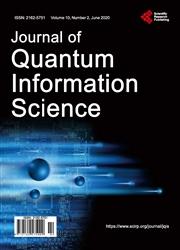Toward Constructing a Continuous Logical Operator for Error-Corrected Quantum Sensing
引用次数: 1
Abstract
Error correction has long been suggested to extend the sensitivity of quantum sensors into the Heisenberg Limit. However, operations on logical qubits are only performed through universal gate sets consisting of finite-sized gates such as Clifford+T. Although these logical gate sets allow for universal quantum computation, the finite gate sizes present a problem for quantum sensing, since in sensing protocols, such as the Ramsey measurement protocol, the signal must act continuously. The difficulty in constructing a continuous logical operator comes from the Eastin-Knill theorem, which prevents a continuous signal from being both fault tolerant to local errors and transverse. Since error correction is needed to approach the Heisenberg Limit in a noisy environment, it is important to explore how to construct fault-tolerant continuous operators. In this paper, a protocol to design continuous logical z-rotations is proposed and applied to the Steane Code. The fault tolerance of the designed operator is investigated using the Knill-Laflamme conditions. The Knill-Laflamme conditions indicate that the diagonal unitary operator constructed cannot be fault tolerant solely due to the possibilities of X errors on the middle qubit. The approach demonstrated throughout this paper may, however, find success in codes with more qubits such as the Shor code, distance 3 surface code, [15,1,3] code, or codes with a larger distance such as the [11,1,5] code.构造用于纠错量子传感的连续逻辑算子
长期以来,人们一直建议进行误差校正,以将量子传感器的灵敏度扩展到海森堡极限。然而,对逻辑量子位的操作只能通过由有限大小的门(如Clifford+T)组成的通用门集来执行。尽管这些逻辑门集允许通用量子计算,但有限的门大小给量子传感带来了问题,因为在传感协议(如拉姆齐测量协议)中,信号必须连续作用。构造连续逻辑算子的困难来自Eastin-Knill定理,该定理防止连续信号对局部误差和横向误差都具有容错性。由于在噪声环境中需要进行纠错才能接近海森堡极限,因此探索如何构造容错连续算子是很重要的。本文提出了一种设计连续逻辑z旋转的协议,并将其应用于Steane码。利用Knill-Laflamme条件研究了所设计算子的容错性。Knill-Laflamme条件表明,仅由于中间量子位上存在X个错误的可能性,所构造的对角酉算子不能是容错的。然而,本文中演示的方法可能在具有更多量子位的代码中获得成功,如Shor代码、距离3表面代码、[15,1,3]代码或具有较大距离的代码,如[11,1,5]代码。
本文章由计算机程序翻译,如有差异,请以英文原文为准。
求助全文
约1分钟内获得全文
求助全文

 求助内容:
求助内容: 应助结果提醒方式:
应助结果提醒方式:


